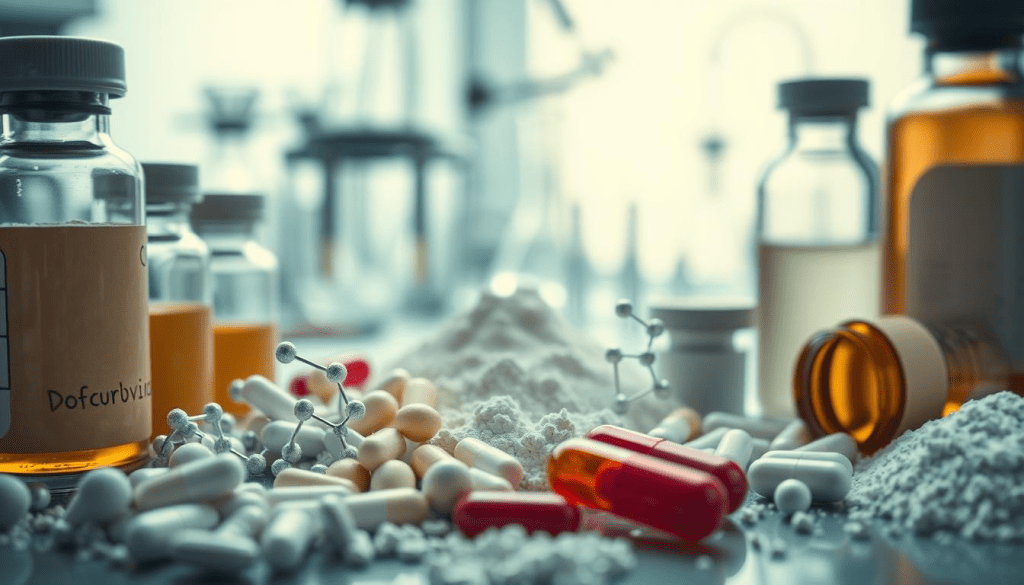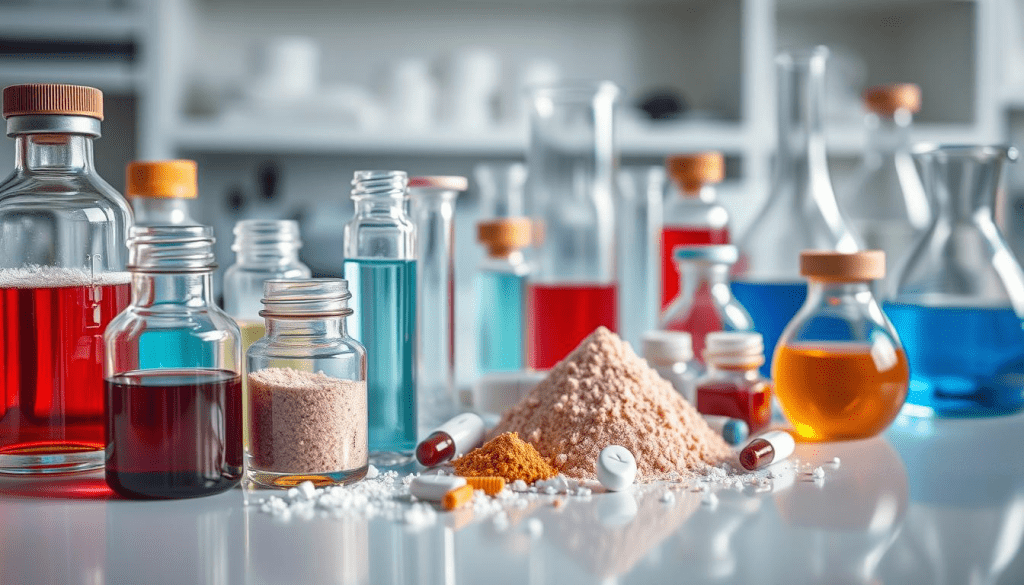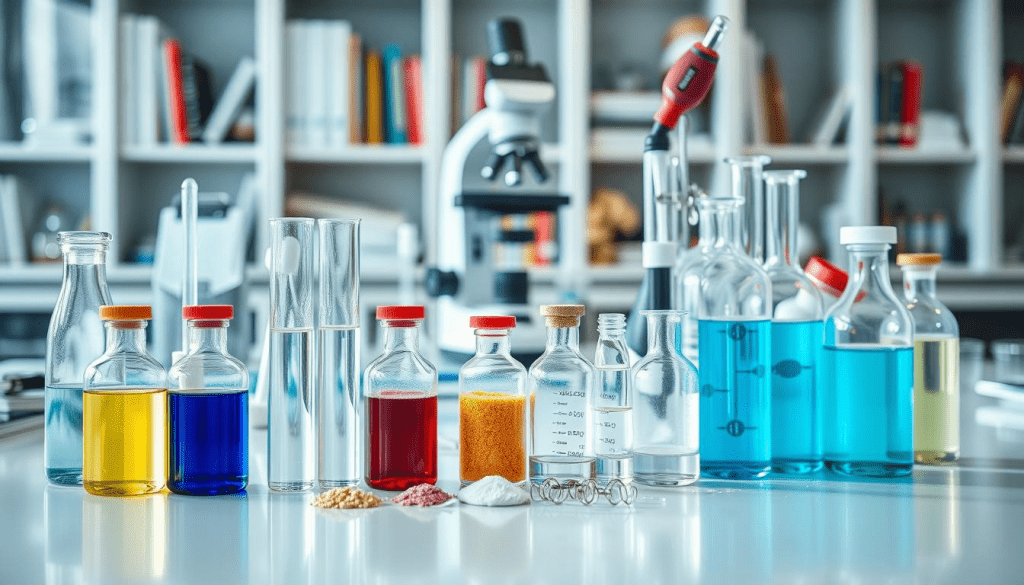Last Updated on November 27, 2025 by Bilal Hasdemir

Knowing what chemotherapy drugs are made of is key for patients. At Liv Hospital, we aim to give top-notch medical care and support. Many patients ask what are chemotherapy drugs made of, and these drugs include a wide variety of ingredients such as chemical compounds, plant extracts, synthetic molecules, and natural products that work to target and destroy cancer cells.
These ingredients are made to fight and kill cancer cells. There are lots of chemotherapy types, each working differently. Our team is here to offer personalized care and help every step of the way.
Key Takeaways
- Chemotherapy drugs contain diverse ingredients, including chemical compounds and plant-derived substances.
- These ingredients target and destroy cancer cells.
- There are many different types of chemotherapy, each working in unique ways.
- At Liv Hospital, we provide complete support and care tailored to you.
- Understanding chemotherapy ingredients is vital for those going through treatment.
The Science Behind Chemotherapy Medications

Chemotherapy uses special chemicals to fight cancer. These medicines are made to target and kill cancer cells. Cancer cells grow and divide quickly.
How Chemotherapy Targets Cancer Cells
Chemotherapy affects cells that are growing and dividing. It targets cells at different stages of growth. There are five main types of chemotherapy drugs.
Alkylating agents, antimetabolites, antitumor antibiotics, plant alkaloids, and synthetic corticosteroids each work differently. They all aim to stop cancer cells from growing.
Alkylating agents damage DNA in cancer cells, stopping them from making more cells. These drugs are used alone or with others. Research shows they are effective against many cancers.s
The Evolution of Chemotherapy Drug Development
Chemotherapy drug development has grown a lot over time. Early discoveries came from chance and observation. For example, nitrogen mustards from World War I led to alkylating agents.
Now, making chemotherapy drugs is more advanced. It includes targeted therapy and immunotherapy.
| Chemotherapy Drug Category | Mechanism of Action | Examples |
| Alkylating Agents | Damage the DNA to prevent cancer cell reproduction | Cyclophosphamide, Chlorambucil |
| Antimetabolites | Interfere with DNA synthesis | Methotrexate, Fluorouracil |
| Antitumor Antibiotics | Bind to DNA and prevent RNA synthesis | Doxorubicin, Bleomycin |
Knowing how chemotherapy works is key to understanding its role in fighting cancer. As research goes on, we’ll see new, better treatments with fewer side effects.
What Are Chemotherapy Drugs Made Of: A Comprehensive Overview

It’s key to know what chemotherapy drugs are made of for effective treatment. These drugs are complex and contain various ingredients. Each ingredient has a specific role in fighting cancer.
Chemotherapy drugs come from different places. They can be from natural or synthetic sources. Natural components include plant extracts, like those from the periwinkle plant or the Pacific yew tree. These are used to make some chemotherapy drugs.
Natural vs. Synthetic Components
Chemotherapy drugs can come from nature or be made in a lab. Natural sources include plants and microorganisms. Synthetic components are man-made chemicals that target cancer cells. Both are important in chemotherapy.
- Natural components: Derived from plants, bacteria, or fungi.
- Synthetic components: Man-made chemicals designed to target cancer cells.
Active Ingredients vs. Carrier Substances
Chemotherapy drugs are made of active ingredients and carrier substances. Active ingredients kill cancer cells directly. Carrier substances help get these ingredients into the body or keep the drug stable.
Understanding the parts of chemotherapy drugs shows how complex cancer treatment is. It also shows why we need to keep researching to make treatments safer and more effective.
Alkylating Agents: From Chemical Warfare to Cancer Treatment
Alkylating agents are a type of chemotherapy drug. They were first made from chemical warfare compounds. These drugs work by damaging the DNA of cancer cells, stopping them from growing. We’ll look into their history, how they work, and examples of these important drugs.
Historical Development of Nitrogen Mustards
Nitrogen mustards were first made as chemical weapons in World War I and World War II. They were found to harm lymphocytes, leading to their use in cancer treatment. The first trials of nitrogen mustards for cancer were in the 1940s, starting alkylating agent chemotherapy.
To make nitrogen mustards safe for medical use, scientists changed their chemical makeup. This created different versions of nitrogen mustards used in chemotherapy.
Chemical Structure and Mechanism of Action
Alkylating agents form bonds with important molecules, like DNA. This damage stops cancer cells from copying themselves. They do this by adding an alkyl group to DNA, causing breaks and cross-links that kill cells.
The way alkylating agents are structured lets them attach to DNA. This is key to their effect on fast-growing cancer cells.
Common Examples and Their Compositions
Many alkylating agents are used in chemotherapy, including:
| Drug Name | Chemical Class | Used for |
| Cyclophosphamide | Nitrogen Mustard | Lymphomas, Leukemia, Breast Cancer |
| Chlorambucil | Nitrogen Mustard | Chronic Lymphocytic Leukemia |
| Melphalan | Nitrogen Mustard | Multiple Myeloma, Ovarian Cancer |
| Busulfan | Alkyl Sulfonate | Chronic Myeloid Leukemia |
These drugs come in pills and injections. They contain active parts and helpers that make them work well.
Antimetabolites: Mimicking Cellular Building Blocks
Antimetabolites are key in fighting cancer. They look like the DNA and RNA building blocks, stopping cancer cells from growing. These drugs mess with DNA making, which cancer cells need to grow fast.
How Antimetabolites Disrupt DNA Synthesis
Antimetabolites look like DNA and RNA parts. They get mixed into DNA, acting as fake blocks. This stops DNA making and slows down cancer cell growth.
5-fluorouracil (5-FU) is a famous one. It blocks an enzyme needed for DNA making. This causes DNA mistakes and kills off cancer cells.
Key Chemical Components and Their Origins
Antimetabolites come from nature or are made in labs. They’re made to look like DNA and RNA parts. Their shape is key to stopping DNA from being made.
Creating these drugs means changing natural DNA parts. For example, methotrexate looks like folic acid, needed for DNA. It blocks DNA making by competing with folic acid.
Examples of Common Antimetabolite Drugs
Many antimetabolite drugs are used in cancer treatment. Each works in its own way. Here are a few:
| Drug Name | Mechanism of Action | Common Uses |
| 5-Fluorouracil (5-FU) | Inhibits thymidylate synthase | Colorectal, breast, and skin cancers |
| Methotrexate | Inhibits dihydrofolate reductase | Leukemia, lymphoma, breast cancer |
| Gemcitabine | Inhibits DNA synthesis | Pancreatic, breast, ovarian, and non-small cell lung cancers |
These drugs have greatly helped in treating cancer. Knowing how they work shows the smart design of modern cancer treatments.
Platinum-Based Compounds in Chemotherapy
Chemotherapy has been greatly improved by platinum-based compounds like cisplatin. These compounds are key in treating many cancers. We’ll look at how they were discovered, their chemical makeup, and new developments.
The Discovery and Development of Cisplatin
In the 1960s, cisplatin was discovered by accident. Cisplatin works by binding to DNA, stopping cancer cells from growing. It’s effective against cancers like testicular, ovarian, and bladder cancers.
Chemical Properties of Platinum Compounds
Platinum compounds, like cisplatin, have special properties. They can link DNA, stopping cancer cells from copying. The structure of cisplatin, cis-diamminedichloroplatinum(II), is key to its effectiveness.
Next-Generation Platinum Drugs
After cisplatin’s success, new drugs like carboplatin and oxaliplatin were developed. These drugs aim to have fewer side effects and work against more cancers. For example, oxaliplatin is mainly used for colorectal cancer.
| Platinum Compound | Primary Use | Notable Characteristics |
| Cisplatin | Testicular, ovarian, bladder cancers | High efficacy, significant side effects |
| Carboplatin | Ovarian, lung, head, and neck cancers | Fewer side effects than cisplatin, often used in combination therapies |
| Oxaliplatin | Colorectal cancer | Used in combination with other drugs, has a different side effect profile |
We’ve covered the basics of platinum-based compounds in chemotherapy. From their discovery to new developments, we see their importance in fighting cancer.
Plant-Derived Alkaloids in Cancer Treatment
Plant-derived alkaloids are a big step forward in fighting cancer. These natural compounds target cancer cells well. They have made chemotherapy more effective for patients.
Taxanes from Yew Trees
Taxanes come from yew trees and are a type of plant-derived alkaloid. They stop cells from dividing, which slows down cancer growth. Paclitaxel and docetaxel are two taxanes used in treatment. Studies show they work well against many cancers, as seen in this research.
Vinca Alkaloids from Periwinkle Plants
Vinca alkaloids are found in periwinkle plants and are key in cancer treatment. Vinblastine and vincristine stop cells from dividing by messing with their structure. This helps slow down tumor growth.
“The discovery of vinca alkaloids marked a significant milestone in the development of chemotherapy, giving new hope to cancer patients.”
The Extraction and Synthesis Process
Getting plant-derived alkaloids ready for use is a detailed process. First, they are pulled from plants. Then, they are cleaned and made into forms that can be used in treatment. New tech has made this process better, helping more people get these drugs.
| Plant-Derived Alkaloid | Source Plant | Mechanism of Action |
| Taxanes (Paclitaxel, Docetaxel) | Yew Trees | Inhibit cell division by stabilizing microtubules |
| Vinca Alkaloids (Vinblastine, Vincristine) | Periwinkle Plants | Disrupts microtubule formation, inhibiting cell division |
In summary, plant-derived alkaloids are essential in cancer treatment. They offer effective treatments for patients. Research and development are ongoing to make them even better.
Antitumor Antibiotics: Harnessing Microbial Power
Antitumor antibiotics are key in fighting cancer. They come from bacteria and fungi. These compounds are vital in chemotherapy.
Bacterial and Fungal Sources
Some microorganisms make antitumor antibiotics. Bacteria like Streptomyces are big producers. For example, doxorubicin comes from Streptomyces peucetius.
Fungi also create these medicines. Bleomycin, for instance, comes from Streptomyces verticillioides.
Chemical Structures and Modifications
Antitumor antibiotics work by getting in between DNA strands. This stops RNA and DNA from being made. They also mess with an enzyme needed for DNA to copy itself.
Some, like bleomycin, create free radicals. These radicals damage DNA directly.
Changing the chemical makeup of these drugs has made them better. For example, doxorubicin in liposomes is safer for the heart.
Examples and Applications
Anthracyclines, like doxorubicin and epirubicin, fight many cancers. These include breast cancer, lymphoma, and leukemia. Bleomycin is used in treatments for Hodgkin’s lymphoma and testicular cancer.
- Doxorubicin is a key part of CHOP for non-Hodgkin lymphoma.
- Epirubicin helps with breast cancer.
- Bleomycin is good against some germ cell tumors.
Understanding antitumor antibiotics shows their importance in cancer battles. These drugs, made from microbes, are essential in chemotherapy. They offer hope and healing to people all over the world.
Topoisomerase Inhibitors and Their Chemical Makeup
Topoisomerase inhibitors target enzymes that help DNA replicate and repair. They are key in chemotherapy. These drugs treat cancer by blocking these enzymes.
Natural Sources and Synthetic Derivatives
These inhibitors come from nature or are made in labs. Natural sources include plants and microorganisms with these properties. For example, camptothecin, a topoisomerase I inhibitor, comes from the Camptotheca acuminata tree.
How These Chemicals Interfere with DNA Repair
These inhibitors block topoisomerase enzymes. These enzymes are vital for DNA replication and repair. By stopping them, the inhibitors prevent DNA replication in cancer cells, leading to cell death.
This action is key to their role in chemotherapy.
The success of topoisomerase inhibitors in cancer treatment shows progress in drug development. As we learn more about cancer, these drugs remain essential in treatment plans.
Corticosteroids and Hormonal Agents in Chemotherapy
Chemotherapy often uses corticosteroids and hormonal agents to fight cancer cells. These tools are key in treating many cancers. They help doctors care for patients in different ways.
Corticosteroids help kill some cancer cells by causing them to die. Hormonal agents, on the other hand, stop hormones that help cancer grow. This is important for cancers that are sensitive to hormones.
Synthetic Hormone Structures
Synthetic hormones are made to act like or block natural hormones. In chemotherapy, they target cancer cells that need hormones to grow.
Thanks to synthetic hormones, doctors can treat cancers like hormone-positive breast and prostate cancer better.
Mechanism of Action in Cancer Treatment
Corticosteroids and hormonal agents work in many ways to fight cancer. Corticosteroids can cause lymphoid malignancies to die. Hormonal agents stop cancer cells from getting the hormones they need to grow.
For example, in hormone-positive breast cancer, drugs like tamoxifen and aromatase inhibitors block estrogen. This stops tumors from growing.
- Selective estrogen receptor modulators (SERMs) like tamoxifen
- Aromatase inhibitors such as letrozole and anastrozole
- Anti-androgens used in the treatment of prostate cancer
These agents have changed how we treat hormone-sensitive cancers. They give patients better, more focused treatments.
Supporting Ingredients in Chemotherapy Formulations
Chemotherapy drugs have more than just the active ingredients. They also have supporting components that help with delivery and side effects. These ingredients are key to making chemotherapy effective and easier for patients to handle.
Solvents and Stabilizers
Chemotherapy needs solvents to dissolve the active ingredients and stabilizers to keep them potent. Solvents like saline solution or dextrose help in giving the drugs. Stabilizers prevent the active ingredients from breaking down, keeping the drug effective from start to finish.
- Saline solution
- Dextrose
- Water for injection
Delivery Enhancers and Bioavailability Agents
Delivery enhancers and bioavailability agents are added to some chemotherapy formulas. They help get the active ingredients to the right place in the body. For example, some surfactants make drugs that don’t dissolve well easier to use, while others help cells take in the drugs better.
Anti-Nausea and Protective Compounds
Chemotherapy can cause nausea and vomiting. To lessen these side effects, anti-nausea compounds are added. Protective compounds also help keep healthy tissues safe from chemotherapy’s harmful effects. For instance, dexrazoxane protects the heart from damage by certain drugs.
- Ondansetron
- Dexamethasone
- Dexrazoxane
Understanding these supporting ingredients shows the detailed work in making chemotherapy drugs. These parts not only make the treatment work better but also help patients live better during chemotherapy.
Modern Innovations in Chemotherapy Drug Composition
Recent advancements in chemotherapy drug composition are changing cancer treatment. They make treatments more effective and less harsh. We’re seeing a big move towards more precise and advanced delivery methods.
Targeted Delivery Systems
Targeted delivery systems aim to send chemotherapy drugs straight to cancer cells. This cuts down harm to healthy cells. It makes treatments work better and side effects less severe.
A study in the Journal of Clinical Oncology found that these systems work well. They lead to better patient results and less harm.
“Targeted therapy is a significant advancement in cancer treatment, giving new hope for patients with specific types of cancer.”
Nanoparticle Formulations
Nanoparticle formulations are another big step in chemotherapy. These tiny particles carry drugs, allowing for precise and controlled delivery.
- Nanoparticles can be made to target specific cancer cells.
- They help drugs dissolve better.
- Nanoparticles can lower the needed dosage and reduce side effects.
| Feature | Nanoparticle Formulations | Traditional Chemotherapy |
| Targeting Ability | High | Low |
| Side Effects | Reduced | Significant |
| Dosage Required | Lower | Higher |
Antibody-Drug Conjugates
Antibody-drug conjugates (ADCs) combine the precision of antibodies with the power of chemotherapy. They are made to target cancer cells, protecting healthy tissues.
Key benefits of ADCs include:
- High specificity for cancer cells.
- Reduced systemic toxicity.
- Improved therapeutic index.
As we keep exploring and improving these innovations, the future of chemotherapy looks bright. We’re on the path to even more effective and tailored treatments.
Conclusion: The Complex Chemistry Behind Cancer Treatment
Chemotherapy is a complex treatment that uses chemicals to target cancer cells. It’s important to understand the chemistry behind it to improve patient care. At Liv Hospital, we focus on giving our patients the best care during chemotherapy.
The chemistry of chemotherapy drugs is complex. It involves many ingredients like alkylating agents and antimetabolites.
Knowing how chemotherapy drugs work helps us fight cancer better. This knowledge is key to improving cancer treatment and helping patients worldwide.
FAQ
What are chemotherapy drugs made of?
Chemotherapy drugs are made from different things. They include chemical compounds, parts from plants, and synthetic stuff. These are all designed to kill cancer cells.
What are the main classes of chemotherapy drugs?
There are several main types of chemotherapy drugs. These include alkylating agents, antimetabolites, and platinum-based compounds. Also, there are plant-derived alkaloids, antitumor antibiotics, topoisomerase inhibitors, corticosteroids, and hormonal agents.
How do alkylating agents work in chemotherapy?
Alkylating agents damage the DNA of cancer cells. This stops them from making copies of themselves. Nitrogen mustards are a type of alkylating agent used in treatment.
What are antimetabolites, and how do they disrupt DNA synthesis?
Antimetabolites act like DNA and RNA building blocks, but don’t work properly. They mess up DNA synthesis in cancer cells. This is because they’re similar to natural parts but don’t fit quite right.
What are platinum-based compounds, and how do they work?
Platinum-based compounds, like cisplatin, form bonds with DNA. This stops cells from fixing DNA damage. This leads to cell death.
What are plant-derived alkaloids used in chemotherapy?
Plant-derived alkaloids, like those from yew trees and periwinkle plants, mess with cell division. They do this by disrupting the microtubule network. This stops cancer cells from growing.
What are antitumor antibiotics, and how do they work?
Antitumor antibiotics come from bacteria and fungi. They work by getting into DNA or making free radicals. This damages DNA and stops cancer cells from growing.
What are topoisomerase inhibitors, and how do they work?
Topoisomerase inhibitors block enzymes needed for DNA replication and repair. This stops cancer cells from making copies of themselves. This leads to cell death.
What role do corticosteroids and hormonal agents play in chemotherapy?
Corticosteroids can make certain cancer cells die. Hormonal agents block hormones that help some cancers grow. This is important for hormone receptor-positive breast cancer.
What are the supporting ingredients in chemotherapy formulations?
Chemotherapy formulas include solvents, stabilizers, and delivery enhancers. They also have anti-nausea compounds. These help manage side effects and make treatment more effective.
What are some modern innovations in chemotherapy drug composition?
New advancements in chemotherapy include targeted delivery systems and nanoparticle formulations. There are also antibody-drug conjugates. These aim to get drugs to cancer cells while sparing healthy ones.
What chemicals are used in chemotherapy?
Chemotherapy uses many chemicals. These include alkylating agents, antimetabolites, and platinum-based compounds. They’re all designed to kill cancer cells.
What is in chemotherapy medicine?
Chemotherapy medicine has active ingredients from both natural and synthetic sources. It also includes ingredients to help manage side effects and improve treatment results.
Reference
Cragg, G. M., & Pezzuto, J. M. (2016). Natural Products as a Vital Source for the Discovery of Cancer Chemotherapeutic and Chemopreventive Agents. Medical Principles and Practice, 25(Suppl 2), 41“59. https://pmc.ncbi.nlm.nih.gov/articles/PMC5588531/






